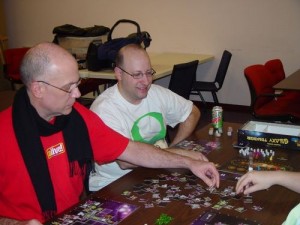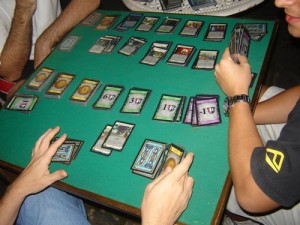Alright, your latest design is a masterpiece. On each player’s turn, that player first allocates workers, then collects resources, then builds units and buildings, then advances on the tech tree, then secretly declares attacks against other players, then rolls to determine battle outcomes, then moves military units to conquered territories, then allocates experience points to individual units. Finally, the player wakes up the next player so he or she can take a turn.

Make like Picard and engage. Image from deviantart.
Today, we’re going to talk about engagement.
Engagement is maintaining player’s attention and interest. While there are times when you might not want to fully engage players (bathroom breaks and non-game socializing can be nice), engagement is generally a very good thing. Having a break when you need one is good, but being forced to take a break, especially a long one, when all you want to do is play a freakin’ game is a very bad thing.
Designing to Engage
When you’re designing a game, it’s probably a good idea to make sure it’s very engaging from the very beginning. There are lots of ways you can make a game engaging.
First off, the more involved a player is, the more engaging it is for that player. That means you should try to minimize the down time each player has.

In Galaxy Trucker, all players create their space ships simultaneously, ensuring that all players are engaged. Image from the Board Game Geek.
Simultaneous gameplay is the ultimate goal here. If all players are always doing something at the same time, they’re all engaged. Great examples of simultaneous gameplay are drafting in 7 Wonders and building your ship in Galaxy Trucker.
The problem, of course, is that simultaneous gameplay makes certain types of mechanics very difficult, if not impossible, to implement. The biggest issue is with timing: if the order in which players take actions will affect what actions are possible or some communal resource (like a board), players will have to take turns to make sure that ambiguities don’t arise. For digital games, the computer mediator can settle timing conflicts. Unfortunately, most mechanics for non-digital games require turns, making simultaneous gameplay a pipe dream.
If your game can’t allow simultaneous gameplay, there are still things you can do to keep it engaging. For one thing, you can keep players’ turns short. If down time is short enough, players won’t have enough time to start getting bored.
Giving players something to think about on other players’ turns is also a good idea. For example, in Dominion, players get to see their hands a turn in advance, so they can start planning their next turn while waiting for other players.
Even more effective, though, is giving each player something to care about on other players’ turns. Settlers of Catan does this very well. When a player rolls to determine which resources will be generated on a turn, everyone cares, because everyone might be able to collect resources. Similarly, when a player trades on his or her turn, all players care, because they all might benefit from a trade. Even though it’s another player’s turn, it still feels like your turn.
Cooperative games like Pandemic also give players incentive to pay attention to other players’ turns, since all players need to use their turns effectively for everyone to win. Just keep in mind that if one dominant player always knows best, other players might stop caring.
Another consideration is that many players will stop caring about a game if they feel like they have no chance of winning. Making actions later in a game worth more victory points than earlier actions can keep hope alive even when a player is behind early on. Another solution is to keep victory points hidden, so players aren’t sure who’s winning or by how much. Corporate America makes use of both of these strategies.
Finally, make sure your game ends while players are still engaged. In my last Board Game Design Basics, I discussed the importance of keeping games short, and this is just one more reason to do so. It may seem counter intuitive to end a game when players are still having fun, but consider the alternative: do you want the game to end when your players are no longer engaged? Even with the most fun experiences, humans can only tolerate so much and will eventually lose interest. Make sure your game ends when they’re still having fun so they’ll remember being engaged and want to play the game again.
Dangerously Boring
There are also things you can try to watch out for to minimize times when players are not engaged. First and foremost, make sure that players’ turns don’t get too long. I know that some people are happy to closely pay attention to what other players are doing on their turns, but many people simply don’t care.

In Dominion, playing your whole deck in one turn is fun… for the person playing. For everyone else, it’s a long reminder that their decks are boring. Image from the Board Game Geek.
Games with unbounded combos are particularly dangerous. In a game like Dominion, players can create decks that will allow them to draw and play cards continuously, making each turn last several minutes. It’s especially brutal when in the middle of the turn someone has to shuffle his or her deck, adding down time when absolutely no one cares what is going on.
Part of what makes unbounded combos problematic is that a player can’t know exactly what he or she will do on his or her turn before it starts, since it will involve drawing new cards and gaining new information that he or she will have to process. It’s not bad to have surprises like this in your game, but it’s a good idea to try to cap how much they can happen so they don’t run amok, leaving everyone else to twiddle their thumbs.
Something else that can keep turns short is to limit both play options and information available to players. It is easy to become overwhelmed when provided with too many possibilities, which can lead to much longer decision making times. If you only have a handful of options, you only have to consider a few choices on your turn. If you don’t have complete information, you can’t meticulously analyze the effects of every single option.
Another big danger is creating games that have systems that are too detailed with too many special rules. Many young designers mistake “detailed simulation” with “fun simulation”, thinking that “realism” will make their games more fun. In my experience, the opposite is often the case. Players get bogged down with annoying rules questions, and while one or two players revel in the details, few do. Little will break a player out of a state of engagement like having to repeatedly consult a rulebook while playing a game.
Games with many details are especially problematic when they distract from the game’s central focus. Battlestar Galactica, a very well loved game, squarely falls into this camp for me. The central mechanics, deception and betrayal, are completely buried in the many complex systems players must understand and think about on each turn. Instead of being engaged in trying to determine who is on whose team, players spend their time and attention struggling to figure out what they need to worry about and how those threats work mechanically.

No matter how fun a game like King of Tokyo is, it’s hard to care about it when you’re dead. Image from the Board Game Geek.
If there’s one thing more disengaging than overly complex rule systems, it’s getting kicked out of a game entirely. This brings us to the ultimate way to disengage players: player elimination. This feature was present is almost all classic board games (like Monopoly and Risk) and even makes appearances in modern games hailed as well designed (like BANG! and King of Tokyo). Nothing will ruin engagement more than being forced to leave a game prematurely while your friends continue to enjoy the game. Thankfully, game designers are growing more and more weary of player elimination. Avoid it in your own designs, and if you absolutely must include it, make sure eliminated players still have some stake in the game (think becoming a bob-omb in Mario Kart 64 battle mode).
Navigating the Fine Line
Remember the game I described at the beginning of this post? Maybe you read the turn description and your mouth started watering. There are definitely players who love that kind of thing and would find it highly engaging. Some players might enjoy it enough to watch with baited breath as other players take their turns, but those people are uncommon.
Different people find different things engaging. Some people love negotiating, some people hate it. Some people love crunching numbers and optimizing, some people hate it. Your game will engage some people and not others, and that’s ok. But remember that the more detailed and complicated it is, the fewer the number of people who will be able to really enjoy it.
When you’re designing a game, you’re usually thinking about what the current player will be thinking and feeling. You’re likely going to create something that will engage that player. That’s the easy part. But don’t forget that few games are played alone, and it’s important that everyone has something to think and care about throughout a game. That’s the challenge. But you’re up to the challenge, right?

Jason Kotzur-Yang (@endgamegames)
/ April 5, 2014Engaging players is very important and you make some good points but you’ve chosen some very poor examples of what not to do. By your own admission, your pointing to well-designed and well-loved games as examples of poor design. I know it’s hard to find examples of bad designs in well-known games because well-known games are generally successful because they’re designed well, but I think Dominion, Battlestar Galactica and King of Tokyo all excel at engaging their players.
There is some downtime in Dominion but it’s handled very well. As you mentioned, you know your hand and you know the options available to you (as they change little between each turn) so you can plan your turn out in advance. The interaction in the game also encourages player to pay attention so they can react to actions and keep an ear out for who has blocking cards. Most importantly, players are fully engaged when it’s their turn with the slightly annoying (when it’s happening to other people) sequence of adding actions and cards to expand your options.
I understand that BSG is a complex game and far from approachable, but that doesn’t fit into your definition of maintaining players’ interest. BSG encourages players to always pay attention to others actions so there’s little downtime. Analysis paralysis is rare as players talk about effects of actions and the best path forward. The turn sequence is smart as each player gets their move and action (which they can even use to give others actions) then all players face a crisis together. While other complex games, such as Twilight Imperium, essentially make you sit on your hands while others are playing, BSG creates a truly collaborative (but not always cooperative 😉 ) game experience. The learning curve in BSG is definitely steep, especially when learning from the rulebook (as opposed to experienced players) but it’s one of the most intense and engaging games I’ve ever played.